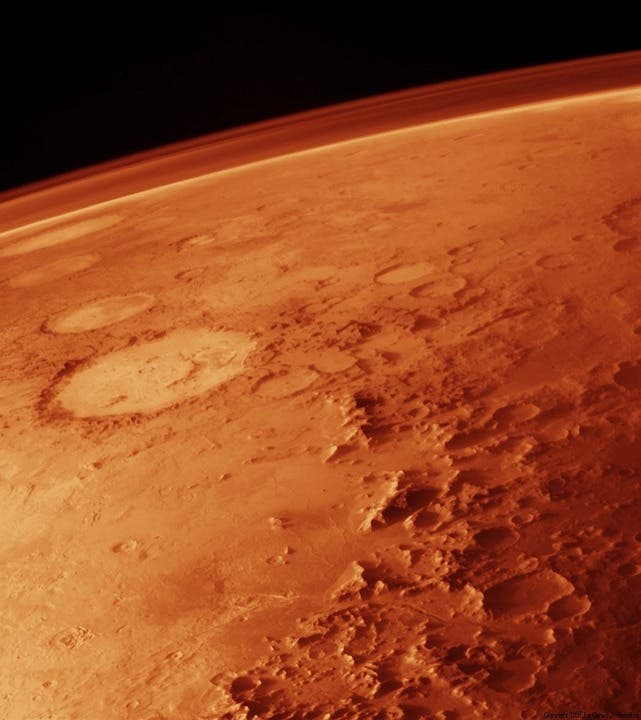Mars’ lack of water and of a magnetic field could be linked, new research proposes.
Despite being a pretty inhospitable place today, Mars used to have liquid water aplenty and an atmosphere. Taken together, these likely made the red planet not that unlike our own Earth — which is to say, ‘comfortable’. Sometime in the past, however, both the water and the air vanished. Our working theory is that it was caused by Mars’s magnetic field, which waned then disappeared roughly 4 billion years ago. Without it to insulate the planet, solar winds flayed it of its atmosphere, slowly turning it into the dry ball of dust and rock we see today.
Magnet..Oh…
It’s a compelling story, but there is one especially frustrating piece missing from it: what killed off the magnetic field? Last week, at the at the Lunar and Planetary Science Conference held in Texas, planetary scientist Joseph O’Rourke presented a new theory which could fill in this missing piece. He believes that the disappearance of the planet’s magnetic field is connected to its missing surface water.
To the best of our knowledge, planets produce their magnetic fields through the churning of their molten, ferrous cores. Convection — where the heated part of a molten material rises to the top, to be replaced by the denser, colder part on top — keeps this metal moving. And just like a dynamo, where you have moving iron, you get a magnetic field.
O’Rourke’s theory is that an influx of hydrogen, sourced by the splitting of water molecules deeper into the Martian mantle, could have stalled this dynamo — and with it, Mars’ magnetic field. Convection relies on differences in density to keep material (in our case, molten iron) moving. But if a lighter material — and it’s hard to get lighter than hydrogen — settles relatively close to the bottom of the convection cell, it can block denser material from sinking back down. It clogs the system.
“Too much hydrogen and you can shut down convection entirely,” he said. “Hydrogen is a heartless killer.”
O’Rourke, from the Arizona State University in Tempe, worked together with Dan Shim, a colleague at the University, to determine where all this hydrogen could have come from. They believe it was sourced from water that was chemically locked in Martial minerals. While it would remain stable in the upper layers of the mantle, the incredible heat and pressures closer to the core could pull these water molecules out of their minerals, and then break them apart. The oxygen atom, being highly reactive, would go on to form new compounds — while the hydrogen atoms would build up near the core and stall convection.
This meddling hydrogen
So, was there enough water in Mars’ mantle for the job? The authors note that Mars’ crust is rich in olivine, a material that doesn’t bond very well with water, and so it remains relatively dry. At deeper levels, where there’s more pressure, this olivine transforms into the minerals wadsleyite and ringwoodite, which do hold more water. Deeper still, the mineral turns into bridgmanite and becomes dry again. According to the team, this bridgmanite layer should act as a buffer, keeping water away and insulating the convection cell. So far, the situation on (in?) Mars is very similar to that on Earth — the same minerals are involved, and there’s no reason to believe that they would behave differently on Mars.
However, there is one important distinction between the two planets — Mars’ mantle cooled down significantly, while Earth’s remains hot. Temperature plays a key role here because it’s the combination of high pressure at high temperatures that prompts the transition to bridgmanite and later keeps it stable. In a progressively cool mantle, like Mars’, the bridgmanite layer would shrink and eventually disappear altogether.
Whether or not this mineral survived in Mars’ interior depends on how large the planet’s core is. We don’t yet know how large it is, but NASA’s InSight Mars lander, scheduled for launch on May 5th, may find out.
One interesting implication of O’Rourke’s theory is that if hydrogen did clog up the magnetic field, it did so surprisingly fast — previous research suggests that Mars’ magnetic field disappeared quite rapidly, over 100 million years’ time.
For now, we’ll have to wait for InSight to launch, and see if the theory stands up to measurements taken in the field. Whatever the results may be, one thing is certain: Mars’ stubborn lack of a magnetic field is bad for business. Hopefully, this research will offer some insight as to how we can fix it.
The paper “Suppressing the Martian Dynamo with Ongoing Hydrogenation of the Core by Hydrated Mantle Minerals” has been presented at the 49th Lunar and Planetary Science Conference, The Woodlands, Texas, on March 21, 2018.










